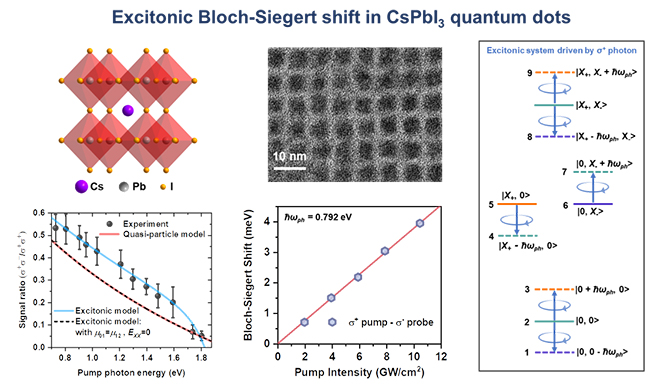A research group led by Prof. WU Kaifeng and ZHU Jingyi from the Dalian Institute of Chemical Physics of the Chinese Academy of Sciences recently reported the observation of an excitonic Bloch-Siegert shift in CsPbI3 perovskite quantum dots (QDs), which advances current fundamental understanding for coherent light-matter interaction in low-dimensional solid-state materials.
The study was published in Nature Communications on Sep. 22.
Coherent interaction between a two-level system and a periodic light field contains both co- and counter-rotating wave parts, which correspond to the so-called optical Stark effect and Bloch-Siegert shift, respectively. Observing the latter has been challenging, not only because it is weak but it is often accompanied by a much stronger Stark shift.
This challenge was recently tackled by leveraging the valley-exclusive optical selection rules in monolayer transition metal dichalcogenides (TMDs) to separate the optical Stark effect and Bloch-Siegert shift to distinct valleys. However, the valley exclusivity is applicable only under a quasi-particle representation. Several recent studies have revealed the significance of many-body interactions in these low-dimensional materials, resulting in the biexcitonic optical Stark effect that could not emerge in a quasi-particle, valley-exclusive picture. But the impact of the excitonic effect on the Bloch-Siegert shift remains unresolved.

Observation of an excitonic Bloch-Siegert shift in CsPbI3 perovskite quantum dots (Image by LI Yuxuan)
In this study, the researchers reported a strong excitonic Bloch-Siegert shift in CsPbI3 QDs at room temperature. The band structure and spin-orbit coupling of this material led to spin-selective quasi-particle transition rules, analogous to the valley-selectivity in TMDs, thus offering a new playground to test excitonic effects on the optical Stark effect and Bloch-Siegert shift.
Importantly, unlike TMDs whose excitonic interaction depended sensitively on their underlying substrates, potentially responsible for the disparity in the above-mentioned studies of TMDs, the excitonic interaction in these colloidal QDs was deterministically strong, as they were uniformly surrounded by low-refractive-index organic ligands and solvents.
The researchers found that by controlling the light helicity, they could largely restrict the optical Stark effect and Bloch-Siegert shift to different spin-transitions, especially when the pump light was tuned from visible to infrared, achieving a Bloch-Siegert shift as strong as four meV.
The ratio between the Bloch-Siegert and optical Stark shifts was found to be systematically higher than the one predicted by the quasi-particle picture at 12 different pump wavelengths. By accounting for the co- and counter-rotating Floquet states of ground, exciton, and biexciton states, they quantitatively reproduced the experimental observations with a biexciton binding energy of 65 meV.
"Our new model depicts a unified physical picture of the interplay between the optical Stark effect, biexcitonic optical Stark effect and Bloch-Siegert shift in low-dimensional materials displaying strong many-body interactions," said Prof. WU, "Such a picture forms the basis for the implementation of these coherent effects to information processing, optical modulation and Floquet engineering." (Text by LI Yuxuan)